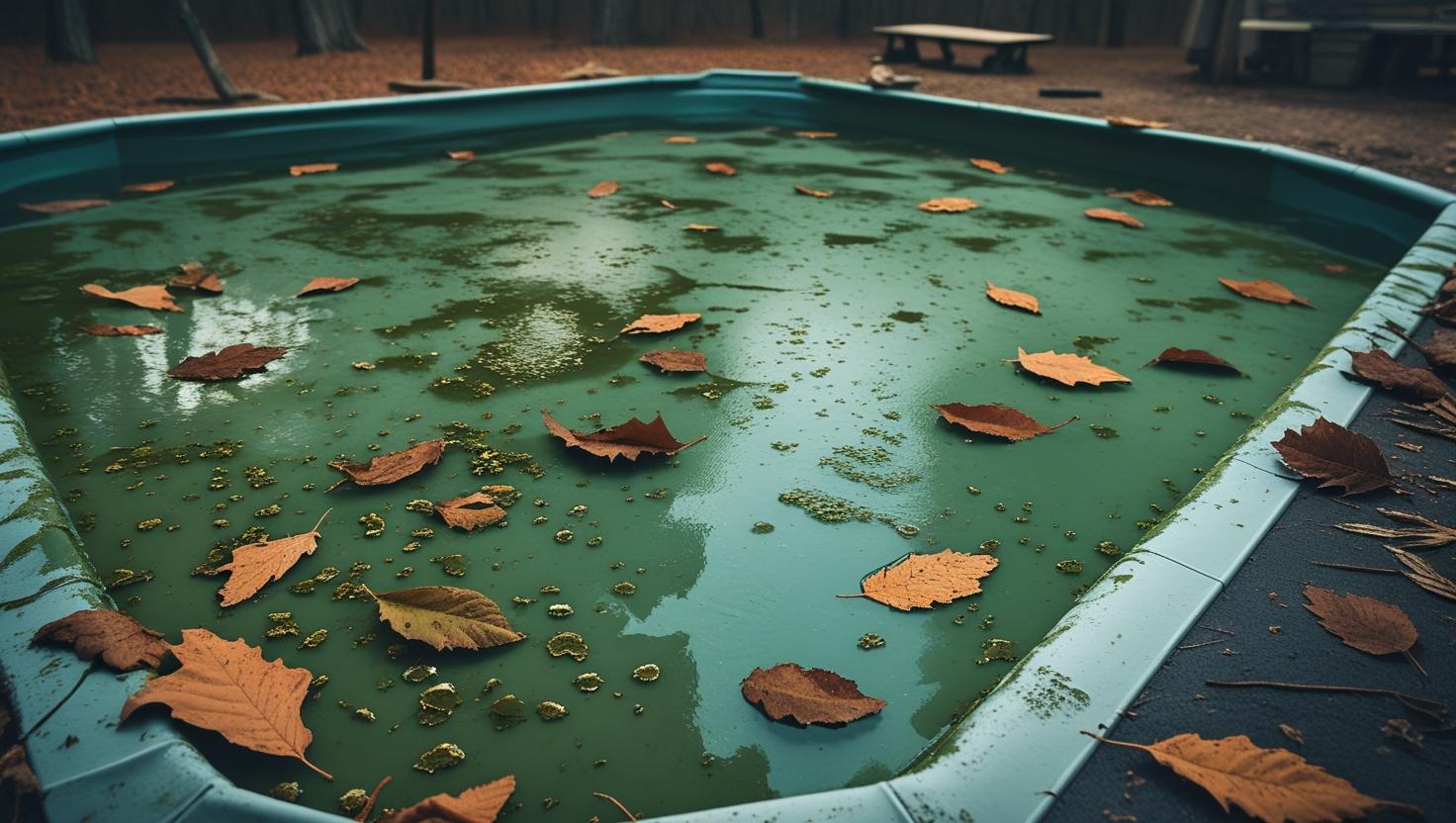Imagine coming back to your backyard pool in spring, expecting a clean oasis but finding a green, debris-clogged swamp instead. What happens if you don’t cover a pool during the off-season? Uncovered pools quickly become magnets for fallen leaves, dirt, and bugs, and sunlight fuels stubborn algae blooms. The results are cloudy water, clogged filters, and a lot more work (and expense) to restore balance. In this post we’ll explore why leaving your pool open causes these headaches and how using a cover (or even a simple net) helps prevent them.
Debris Accumulation
- Fallen leaves and dirt: An uncovered pool collects leaves, twigs, pollen and dust. These materials float and sink in the water, making it dirty. As Flipr explains, leaves decompose and release organic matter into the poolflipr.shop. Over time this debris can even stain surfaces and feed algae.
- Clogged equipment: Debris in the water eventually clogs skimmer baskets and filters. Pool experts warn that debris like leaves and pine needles can “block skimmer baskets, clog pump impellers, and hinder the proper functioning of filters”alphawest.com. In practice, this means you’ll have to clean the skimmer and filter much more often than if the pool were covered.
- Increased cleaning: Without a cover, the amount of debris in the pool grows each day. Even a quick note from Aquascapes Pools stresses that if a pool is left uncovered for winter, “debris will start to build up”aquascapespools.com. As a result, manual skimming and vacuuming become a constant chore. Latham Pool’s guide on winterizing notes that “unless you cover your pool, [you must] clean the skimmer weekly, maintain the filter… and vacuum as needed”lathampool.com.
Algae Growth from Sunlight and Organic Matter
- Sunlight fuels algae: Exposed to sun and warm air, pool water becomes an algae playground. As one pool advice site notes, “Algae thrive in warm and sunny conditions, which an uncovered pool provides”solarsafepoolcovers.com. In other words, without a cover the water heats up and receives plenty of UV light – exactly the conditions algae need.
- Nutrient “buffet”: Fallen leaves and debris decay in the water, acting like fertilizer. The breakdown of leaves releases phosphates and nitrates – key nutrients that feed algaeflipr.shop. AlphaWest explains this chain reaction: debris decomposition releases nutrients and “bacteria and algae… seize the opportunity for rapid growth”, turning the water green and cloudyalphawest.com. In short, every leaf left in the pool helps algae multiply.
- Rapid blooms: Even a few days of warm sun can trigger a sudden algae bloom. Once algae starts, the water can turn a murky green quickly, making it unsafe or unpleasant to swim. Clearing it out then requires heavy doses of shock chemicals and brushing.
Chemical Imbalance and Water Evaporation
- Increased evaporation: Uncovered pools lose water fast. The EPA points out that a cover can prevent up to 95% of pool water evaporationepa.gov. Without a cover, you’ll find yourself topping up the water level frequently as sun and wind evaporate it away. This not only wastes water but also changes chemical concentrations in the pool.
- Heat loss: Water evaporation also carries heat away. In fact, R&R Pools notes that letting pool water evaporate can reduce heating costs by 50–70% when covered, implying that an uncovered pool will be expensive to heat. Every gallon of evaporated water draws heat from the remaining water, forcing the heater (or solar blanket) to work overtime.
- Chlorine degradation: Sunlight and evaporation break down pool chemicals. UV rays in sunlight literally destroy chlorine and other sanitizers. According to one pool expert, using a cover can reduce chemical use by up to 60%, because uncovered pools lose chlorine to the sunrrpools.ca. In practice, this means an uncovered pool requires frequent chemical dosing – you’ll add chlorine (and shock treatments) much more often to keep water safe.
- Rainwater dilution: Rain (and sprinkler runoff) also affects balance. Rainwater is essentially distilled, so it dilutes mineral hardness and stabilizer levels. Orenda Technologies explains that without a solid cover, rain and snow can “dilute your pool chemistry over several months,” lowering calcium, CYA and other levelsblog.orendatech.com. This can raise pH and upset the chemical balance, forcing you to test and rebalance more frequently.
Potential Structural Damage from Seasonal Exposure
- Freeze damage: In winter, ice can spell disaster. When water freezes it expands, putting enormous pressure on pool walls and equipment. SolarSafe Pool Covers warns that without a cover, “freezing temperatures can cause water in the pool to expand… potentially leading to cracks” in walls or floorsolarsafepoolcovers.com. In the worst case, a cracked pool shell or liner requires expensive repairs.
- Equipment breakage: Pipes, pumps and filters can also freeze. Water trapped in plumbing or gear will expand when frozen and can rupture valves or filters. For example, American Pool reports that “when water freezes, it expands… any water sitting in the pipelines has nowhere to go,” often resulting in burst pipes and cracked pumpsamericanpool.com. Fixing freeze-damaged equipment can run into the hundreds or thousands of dollars.
- Surface wear: Even aside from freezing, constant sun, rain and debris can degrade pool surfaces over time. UV light fades pool liners and tiles, and falling debris can scratch finishes. In general, an uncovered pool’s shell and accessories (ladders, lights, etc.) simply take more weathering than one that’s protected by a cover.
Increased Time and Maintenance Costs
- More cleaning labor: All of the above problems add up to far more work. Pool owners with no cover spend hours each week skimming, vacuuming and cleaning out filters. Latham Pool notes that a covered pool “will save you time during the winter, as you won’t have to clean your pool… [and] will also reduce the amount of cleaning and maintenance… when it’s time to open your pool”lathampool.com. By contrast, an uncovered pool keeps you chained to chores.
- Higher chemical bills: Because of evaporation, sunlight and contaminants, you’ll use a lot more chemicals. In addition to frequent chlorine shocks, you’ll likely buy extra algaecides, pH adjusters, and clarifiers. All these costs add up compared to the minimal chemicals needed under a cover.
- Increased heating costs: As noted, uncovered pools lose heat quickly. Heating an open pool can bump up gas or electric bills substantially. Fibreglass Pool Co. points out that failing to cover your pool “can result in significantly higher maintenance costs and increased energy bills”thefibreglasspoolcompany.com.au. In other words, what you saved by skipping a cover can be spent many times over on heating.
- Repair and replacement costs: Clogged filters and freeze damage aren’t free to fix. Debris buildup stresses pumps and filters, shortening their lifespan. Similarly, any ice cracks or liner damage must be repaired before they get worse. Fibreglass Pool Co. specifically warns that uncovered pools can lead to “damaged filters and pumps,” requiring costly repairsthefibreglasspoolcompany.com.au. Overall, neglecting to cover your pool often means pay-offs down the line in repair bills and replacement parts.
Tips and Alternatives for Pools Without Covers
If a full pool cover isn’t available, you can still mitigate problems with these measures:
- Use a leaf net or mesh: A leaf net is a simple nylon net you lay over the water to catch leaves and large debrissolarsafepoolcovers.com. It won’t stop evaporation or algae, but it keeps the bulk of debris from sinking. A safety mesh (woven with small holes) offers more support and can even hold weight, though it lets small particles through.
- Install a screen enclosure: If local climate allows, a screened pool cage or lanai can block out most leaves, bugs and rain. This is a bigger investment, but it addresses debris without covering the water directly. (It won’t prevent evaporation, however.)
- Run the pump: Keep water circulating. Even a few hours a day of filtration helps mix in chemicals and prevents stagnation. In freezing conditions, a freeze-protection pump or timer can prevent ice from forming in pipespoolwerx.com. Pool professionals recommend running the pump continuously when temperatures dip below freezing to protect plumbingpoolwerx.com.
- Skim and vacuum regularly: Without a cover, treat cleaning as a daily task. Skim out leaves each morning and vacuum them or empty the net. Keep skimmer baskets and filters clean so your system can keep up.
- Maintain chemicals: Test the water often. Add chlorine, algaecide or shock as needed – especially after heavy sun or rain. Anchor Industries advises that “if you don’t have a pool cover… be sure to check your chlorine level regularly” through the off-seasonanchorinc.com. Keeping sanitizer and pH in range will prevent big imbalances.
- Partial or DIY covers: If cost is a concern, even an inexpensive tarp or solar blanket laid atop the pool helps a little. Lay it flat on the water (not lifted at edges) and secure it. This is not a long-term safety cover, but it will cut some debris and evaporation. Just remember tarps can be dangerous if not used properly.
- Lower the water (for winter): For regions with freezes, consider lowering the water below skimmers and installing freeze plugs. This is part of pool winterizing to avoid ice pressure. (A cover is still recommended, but lowered water gives ice more room to expand without breaking the pool.)
Conclusion
Leaving a pool uncovered comes with predictable downsides: debris, algae, chemical imbalance and even damage to equipment. Covering a pool in the off-season, by contrast, saves time, money and hassle. As Latham Pool points out, “Covering your pool will save you time… and reduce the amount of cleaning and maintenance you will need to do”lathampool.com. Using quality pool covers and nets is a small upfront effort that prevents a giant cleanup later. In short, the question “What happens if you don’t cover a pool?” is answered by extra work and expense – whereas a good cover (or even a leaf net) keeps the water clean, balanced, and ready to swim in when you want.
Sources: Expert pool maintenance guides and articles on covering poolslathampool.comthefibreglasspoolcompany.com.ausolarsafepoolcovers.comflipr.shop, among others. Each detail above is backed by industry advice and research.



